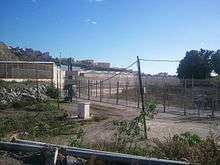Ceuta border fence

The Ceuta border fence forms part of the Morocco–Spain border at Ceuta, a city on the North African coast. Constructed by Spain, its purpose is to stop illegal immigration and smuggling. Morocco objected to the construction of the barrier since it does not recognize Spanish sovereignty in Ceuta.
The fence consists of parallel 6 metre (20-foot)[1] fences topped with barbed wire, with regular watchposts and a road running between them to accommodate police patrols or ambulance service in case of need. Underground cables connect spotlights, noise and movement sensors, and video cameras to a central control booth; dozens of Guard ships and patrol boats check the coast, while 621 Guardia Civil officers and 548 police officers control the shore.[2]
History
In 1993 an 8.4 km (5.2 mi) fence was built around the exclave. As the first fence was too easy to cross the construction of a new system started in 1995. After 13 to 15 people died in a single attempt to cross the border in 2005 an increase of height was made, from 3 to 6 m (9 ft 10 in to 19 ft 8 in).[3]
2005 assault
On 7 October 2005, the border-fence was assaulted by hundreds of migrants, creating international attention. Caught between the Spanish rubber bullets and Moroccan gunfire, a number of migrants died (sources put the number of deaths between thirteen[4] and eighteen people[2]) and more than fifty were injured. Some of the dead were wounded by live ammunition; of those, two died at the Spanish side of the fence,[4] apparently shot from the Moroccan positions.[5] The 2005 events at the Ceuta and Melilla border fences are the subject of a documentary film, Victimes de nos richesses.[6]
Since then, migrants have occasionally died while trying to break through the fence.[1][7]
See also
References
- 1 2 "Spain/Morocco: Protect Migrants, Asylum Seekers". Human Rights Watch. Retrieved 8 November 2014.
- 1 2 Valsecchi, Riccardo (2009-06-25). "Ceuta, the border-fence of Europe". New York: WorldPress.
- ↑ Building Fortress Europe? Schengen and the Cases of Ceuta and Melilla
- 1 2 EUROPA - Press Releases - Visit to Ceuta and Melilla – Mission Report Technical mission to Morocco on illegal immigration 7 October– 11 October 2005
- ↑ Migrants shot dead at the border fence, Spain deploys army
- ↑ Barlet, Olivier. "Victimes de nos richesses". Africultures (in French). Retrieved 16 March 2012.
- ↑ "Spain: Accountability urged for 'appalling' migrant deaths in Ceuta". Amnesty International. Retrieved 8 November 2014.
Bibliography in English
- Ferrer-Gallardo, Xavier. 2008. "The Spanish-Moroccan Border Complex: Processes of Geopolitics, Functional and Symbolic Rebordering." Political Geography 27: 301-321.
- Gold, Peter. 2000. Europe or Africa: A Contemporary Study of the North African Enclaves of Ceuta and Melilla. Liverpool: Liverpool University Press.
- Moffette, David. 2013. "Muslim Ceutíes, Migrants and Porteadores: Race, Security and Tolerance at the Spanish-Moroccan Border." Canadian Journal of Sociology 38(4): 601-621.
- Valsecchi, Riccardo. 2009. "Ceuta, the border-fence of Europe" WorldPress, 25 June 2009.
External links
- Spain: building border fence
- Ceuta, the border-fence of Europe
- Mustafa, the swimming fridge smuggler, and his macabre pact
- Attacking Europe's border fences
- Ceuta border fence photo gallery: 1 2 3 4 5 6 7 8 9
Coordinates: 35°53′53″N 5°21′51″W / 35.89795°N 5.36407°W
